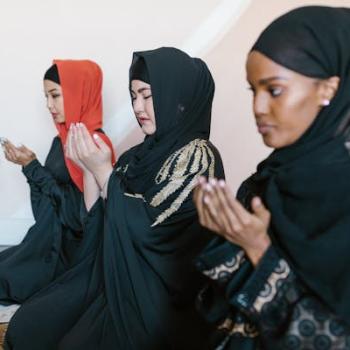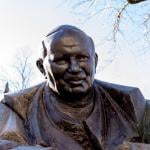
THE RELIGION GUY’S ANSWER:
Well, that’s impossible to say with any accuracy since there’s no one agreed-upon statistical source and some groups do not collect or issue good numbers. We do know two things for sure about the U.S. 1) It remains predominantly Christian despite a recent decline, and 2) There’s been notable growth in non-Christian religions through immigration and conversion.
Recently, some noteworthy new numbers about U.S. Christianity became available. We’ll review those below, but let’s begin with complexities regarding the major non-Christian faith groups.
Judaism is traditionally second in population size to Christianity. The American Jewish Population Project at Brandeis University reports there are 7,631,000 American Jews, children included, among which 4,873,000 are adults and “Jewish by religion” as opposed to a secular ethnic identity. That’s similar to the 7,387,992 ethnic total reported by the American-Israeli Cooperative Enterprise.
A major report by the Pew Research Center, a go-to-source for surveys on American religion, said that as of 2020 there were “approximately” 5.8 million Jewish adults, of whom 4.2 million were “Jews by religion.” Then we can consult these two standard sources:
Two standard sources
== The 3rd edition of the “World Christian Encyclopedia” (Edinburgh University Press), compiled by a study center at Gordon-Conwell Theological Seminary, contains extensive information on all religions in all nations, not just Christianity and not just the United States. It counts 5.6 million Jews of all categories.
== The U.S. Religion Census, compiled once each decade by the Association of Statisticians of American Religious Bodies, yielded 2020 data on 372 religious bodies posted at https://thearda.com/us-religion/census/congregational-membership?t=4&y=2020/ With Jews, the Census primarily used groups’ own reports given to the Synagogue Studies Institute.
This produced a listing of just over 2 million adherents total in Judaism’s three main branches, with small numbers in other religious groups. Perhaps surprisingly, the Orthodox were 47% of that total (a number that did not include the 953 local Chabad groups), followed in size by the Reform and then the Conservative branches.
With Islam, a standard source is the 2019 survey of U.S. mosques led by Ihsan Bagby of the University of Kentucky, and sponsored by Muslims with the Institute for Social Policy and Understanding. The report projects 4 million “mosqued Muslims” attend worship at least for the major festivals at the 2,769 mosques identified by the team. Note that this excludes groups defined as outside the Sunni and Shia “mainstream” such as the U.S.-founded Nation of Islam and Moorish Science Temple, and two international groups, the Ahmadiyyah and Ismailis.
The “World Christian Encyclopedia” counts a U.S. Muslim population of 4.9 million. The U.S. Religion Census estimate updated from Bagby’s project is 4,453,908. The Pew Research Center estimated from trend lines that U.S. Muslims over-all reached 3.85 million by 2020 and will supplant Jews to become the nation’s second-largest religion by 2040.
U.S. Buddhism & Hinduism
Buddhist and Hindu figures in the Census build upon research by J. Gordon Melton of Baylor University, the editor of “Melton’s Encyclopedia of American Religions” (Gale).
Buddhism: The Census reports just over 2 million adherents in three main branches, in order of size the Mahayana, Theravada, and Vajrayana. The “World Christian Encyclopedia” count is 4.39 million.
Hinduism: The Census reports 831,229 adherents in traditional fellowships and another 437,115 practitioners in Hindu meditation or yoga groups. The “World Christian Encyclopedia” number is 1.65 million.
Then we turn to some significant data on Christianity as of 2020, released last November in the U.S. Religion Census. No surprise, the Catholic Church remains by far the largest body with 61,858,137 menbers.
The big news was in the complex Protestant category. An unusually comprehensive survey located 44,319 independent, “non-denominational” congregations that together have 21,095,641 members, now constituting by far the nation’s largest Protestant group. This aspect of the Census drew upon two decades of listings compiled by Scott Thumma of the Hartford Institute for Religious Research.
The statisticians noted considerable churn in this category. A one-year follow-up showed many such local churches on the list had disbanded while new ones had turned up. Thus the Census is called the “best accounting” ;available though it’s not “comprehensive or totally accurate.”
Differing Black Church Data
A second Census aspect dealt with the eight major historically Black Protestant denominations, a perennial challenge for statisticians. Working from available information provided by these groups, the Census reported that all together they have 7,032,000 members.
But the eight denominations’ reports to the 2012 and last edition of the now-defunct “Yearbook of American and Canadian Churches” totaled 22.4 million members. Similarly, the Conference of National Black Churches claims the largest historically Black denominations “have a combined membership of over 20 million people and 30,000 congregations.” (There are similar anomalous reports from Eastern Orthodox Christians.) .
Thirdly, the Census provided detail on the complex “evangelical” and conservative Protestant movement with its Pentecostal and Fundamentalist segments (other evangelicals are counted under the historically Black denominations). Their membership has decisively overtaken the older and more liberal “Mainline” Protestant church bodies that formerly dominated American culture, especially now that we add those 21 million independents, who are heavily evangelical.
Internal disputes brought news attention to, for instance, the large Southern Baptist Convention (17.6 million members) and Lutheran Church—Missouri Synod (1.8 million), while Saturday worship makes the Seventh-day Adventist Church (1.34 million) stand out. But depending on where they live, casual observers may know less about the Assemblies of God (3 million members), the “Churches of Christ” identified by worship without musical instruments (1.4 million) and the similar “Christian Churches and Churches of Christ” (1.38 million),
Evangelicalism is greatly strengthened by smaller groups, also often little-noticed, such as the Church of the Nazarene (905,690), Church of God (Tennessee; 868,446), Wisconsin Evangelical Lutheran Synod (408,259), Church of God (Indiana; 427,038), Christian and Missionary Alliance (414,360), Presbyterian Church in America (372,696), Foursquare Gospel church (363,626), Wesleyan Church (306,005) and several dozen smaller denominations. The Census did not post memberships for further evangelical groups such as the Calvary Chapel and Vineyard networks.













